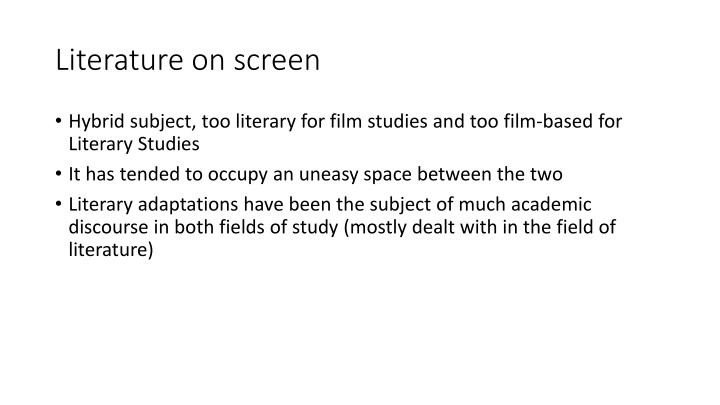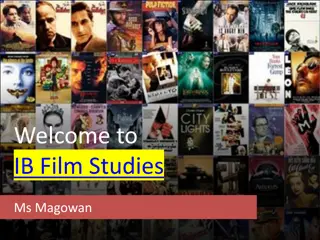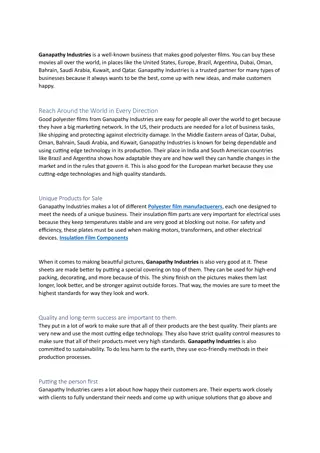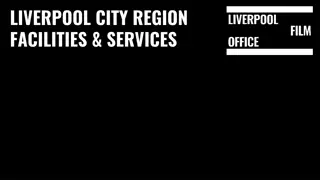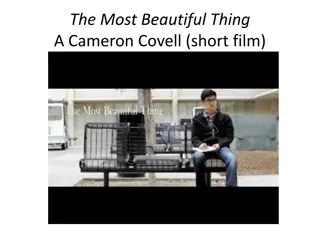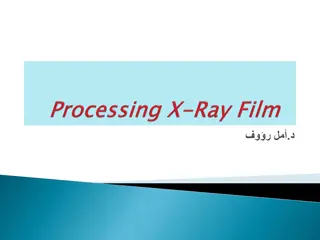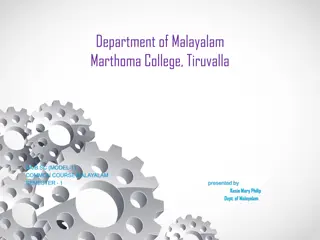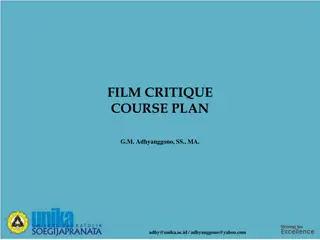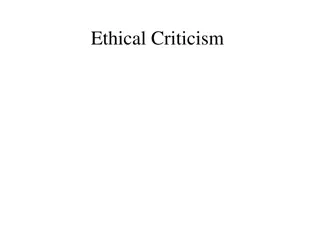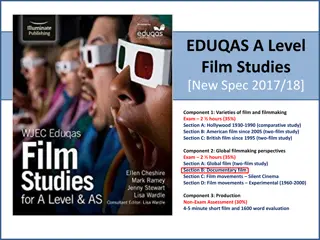Examining the Relationship Between Literature and Film
The intersection of literature and film has sparked academic discourse, exploring adaptations and hybridity. Despite traditional opposition between words and images, critical perspectives have revolutionized how these mediums are perceived, emphasizing their unique qualities. Major contributions by scholars such as Bluestone and Richardson have shed light on the differences and similarities between novels and films, challenging conventional views of fidelity and purity in both forms.
Download Presentation

Please find below an Image/Link to download the presentation.
The content on the website is provided AS IS for your information and personal use only. It may not be sold, licensed, or shared on other websites without obtaining consent from the author.If you encounter any issues during the download, it is possible that the publisher has removed the file from their server.
You are allowed to download the files provided on this website for personal or commercial use, subject to the condition that they are used lawfully. All files are the property of their respective owners.
The content on the website is provided AS IS for your information and personal use only. It may not be sold, licensed, or shared on other websites without obtaining consent from the author.
E N D
Presentation Transcript
Literature on screen Hybrid subject, too literary for film studies and too film-based for Literary Studies It has tended to occupy an uneasy space between the two Literary adaptations have been the subject of much academic discourse in both fields of study (mostly dealt with in the field of literature)
Adaptation of literature into film Adaptation is not the only kind of relationship that might exist between film and literature, but is the one that most persistently preoccupies the theorist, the critic, the reviewer, the filmgoers. Films may engage with literature in ways other than the conventional adaptation.
The Word/Image Wars: the novel and the film Novels and films are traditionally opposed as words and images conceived as irreducible, untranslatable, apriori entities. This belief in an essential opposition of words and images holds strongly still nowadays, even among poststructuralist thinkers. Roland Barthes: there is never a real incorporation since the substances of the two structures (graphic and iconic) are irreducible (1977) Michel Foucault: statements and visibilities are pure, a priori elements (1981) J. Hillis Miller: Neither the meaning of a picture nor the meaning of a sentence is by any means translatable. The picture means itself. The sentence means itself. The two can never meet (1992)
Major critical contributions in the field George Bluestone, Novels into film (1957): first full-lenght and pioneering study of adaptation. He explores the connections between film and novel and their major differences: they are overtly compatible, secretly hostile . According to him the novel is conceptual, linguistic, discursive, symbolic, inspiring mental imagery. Time is its formative principle. The film is perceptual, visual, presentational, given to visual image. Space is its formative principle. The film and the novel should remain separate institutions each acheiving its best results by exploring unique and specific properties Revolutionary approach: he refuses to judge the merits of film versionsof literary texts by the standard of fidelity . Robert Richardson, Literature and Film (1969). He asserts that film and literature are essentially different: what makes a good film doesn t make a good novel and what makes a good novel doesn t make a good film J. Dudley Andrew, Concepts in Film Theory ( 1984) (much quoted scholar of literary film adaptation): novels and films have absolutely different semiotic systems Brian McFarlane (1984): The novel is linear, the film spatial, the novel conceptual and the film perceptual (1996)
The illusory aesthetic of purity Illusory aesthetic of both forms as verbally or imagistically pure. Their hybridity has been mostly denied. What we find when we look at the history, theory, and criticism of film and of the novel is a pervasive tendency not only to treat novels as words and films as images, but to treat films as though they had no words and novels as though they had no images. After all, films abound in words in sound dialogue, intertitles, subtitles, voice-over narration, and words and written texts create visual and spatial effects (for example through ekphrasis).
Blustone and the aesthetic of purity However most critics follow Bluestone s theory: Because neither film nor novel is pure, because the film is suffused with temporal, the novel with spatial, effects, we should not forget the priority of each. For analytic purposes, our emphases will stand. Without visual images there would be no film. Without language there would be no novel.
Film words Film words suffer a pervasive neglect in film history, criticism, and theory. They are subordinated to other modes of representation. The verbal identity of the script itself is underestimated. The script is reduced to a technical blue-print for putting together bits of sight and sound (of which speech is only one element among several)
C. Metz on film words (1991) Christian Metz, perhaps the most famous film semiotician of the twentieth century, is both representative and influential. Like Bluestone, he acknowledges the presence of film words, but does not allow them to be definitive elements of film: The cinema s] strength, or its weakness, is that it encompasses earlier modes of expression. Some, truly languages (the verbal element), and some languages only in more or less figurative sense (music, images, noise). Nevertheless, these languages are not all found on the same plane with respect to cinema: speech, noise, and music were annexed at a later time, but film was born with image discourse. A true definition of cinematographic specificity can therefore only be made on two levels: that of filmic discourse and that of image discourse . Film theorists since Metz have barely studied film words and continue to subjugate them to image or to the aural more generally.
Focus on hybridization of the two forms More recent studies emphasize the contaminations of the two forms and try to overcome the dicothomical opposition between words and images . See for example Robert Stam and Alessandra Raengo (eds.), A Companion to Literature and Film (2004)
Fidelity to the source text as a critical criterion? All these studies, starting from Bluestone, try to free our notion of film adaptation from its dependency on literature Adaptations should not be considered as derivative, therefore inferior to their literary counterparts. Nonetheless many writers and filmakers believe that, if the film is to be a good adaptation, it needs to be faithful to its literary source Best adaptations are often considered as those which preserve and revere the literary text. Brian McFarlane, Novels to Film (1996) contests fidelity as a critical criterion of judgement: fidelity is a wholly inappropriate and unhelpful criterion for either understanding or judgement
The discourse of authenticity Adaptations that aspire to be faithful to their literary source endeavor to give the impression of accuracy in the representation of a literary text. The copy is inevitably doomed to be inferior to its original. Adaptations are merely cheap imitations of a Platonic ideal, which is, by its very nature, inimitable. Comparisons have been drawn between adaptations and the flickering lights described by Plato in The Republic. These lights, seen by the dwellers of a cave who have never seen the real life cannot be substitute for the ideal of the original. Adaptations are seen as a pale copy of the real thing. This belief is prevalent in popular press reviews of film adaptations: films are seen not as good as the books Most recent studies of adaptations regard film adaptation as part of a continuing dialogical process.
Intertextual approaches Most recent studies of adaptations regard film adaptations as readings , as part of a continuing dialogical process and question the idea of the dependency of the film from the literary text. Debora Cartmell and Imelda Whelehan in their Literature on Screen (2007) see literary texts not as primary sources but as intertexts Desmond and Peter Hawks, in their Adaptation: Studying Film and Literature (2006), claim that film can provide a source text for literature McFarlane argues that an adaptation adds to the original narrative a battery of codes, both cultural and cinematic Fidelity criticism is recently undermined by intertextual approaches
Mc Farlane on fidelity Even among the most rigorously high-minded of film viewers confronted with the film version of a cherished novel or play, it is hard to suppress a sort of yearning for a faithful rendering of one s own vision of the literary text. The venture is impossible. Every reading of a literary text is a highly individual act of cognition and interpretation; every such response involves a kind of personal adaptation on to the screen of one s imaginative faculty as one reads . How thus can any film version produce the same responses except by the mearest chance?
McFarlane: misconceptions on films which justify the dependency theory asserting their secondary role A misconception is that film makes fewer demands on the imagination than a book does. This kind of thinking is erroneously based on the belief that coming to terms with a continuous narrative involving a set of characters operating in a given time and place enjoins a greater effort on the part of the reader than it does on that of the viewer. There it all is, exponents of this view will say, up there on the screen, leaving little for us to have to work on, whereas on the page we have to translate those lines of black marks that constitute words, phrases, clauses and sentences into conceptual images. In carrying out this work , more of our intellectual and emotional resources will necessarily be called into play . Subtlety and complexity are recognized in the verbal medium and not in the film
McFarlane: how to come to serious terms with a film? It is not just a matter of allowing the perceptual stimuli film offers us to wash over us, any more than the intelligent reading of a book asks no more than that we skim the lines for the gist of the plot. The film, if it is to make a serious impact on us, will require that we pay attention to the intricate interaction of mise-en- sc ne (what is visibly there in the frame at any given moment), the editing (how one shot of a film is joined-to/separated-from the next) and sound (diegetic or non-diegetic, musical or otherwise) . The viewer should take them all into account Several codes are at work in film, both cinema-specific and extra-cinematic codes The cross-over from the reading of literary texts to the reading of a film is very complex and problematic. Notice how the term reading is much used for films, both strengthening the tie to the earlier medium and implying its primacy.
Sound in films Overlooked aspect in the literature on film studies , which privilege the word-image debate. Music functions as an intermediary presence between spectator and film character, offering a chorus-like insight Whether commissioned for the film, or a well-known piece of music with other associations, music creates a mood, amplifies emotions, emphasizes temporality, offers continuity between cuts and editing
Why the fascination of filmakers for literary texts ? Many of the most popular and most highly regarded films have their roots in literature of one kind and at one level or another. Filmmakers are more often than not deferential in their attitude to the works they are adapting Novels are the most numerously adapted in comparison to other literary genres. What does attract filmmakers to try to render in audio-visual moving images what the novelist has fixed in words? We need to concentrate on what novel and film have in common
Narrative and narration What they share is narrative , what distinguishes them is narration Narrative: a series of events, sequentially and/or consequentially connected by virtue of their involving a continuing set of characters. Narration: all the means by which the narrative has been put before reader or viewer. Narrative makes the two mediums seem compatible
The sense of the real Both novel and film create worlds and lives in more amplitude and more regard for representational realism than any other literary forms. The gap between signifier and signified is narrower than it is in drama and poetry. Drama and poetry are constrained by formal and stylistic characteristics. In novels and films we expect a sense of the real , a sense of diegesis. In both cases the imagination of the consumer is kept alive in creating this world.
How do we respond to screen narrative? In the processes of signification film draws on a battery of codes some cinemaspecific, some more generally cultural. In responding to the stimuli offered by film, viewers must take cognizance of: - linguistic codes (including, for instance, the accents and tones of voice employed by actors, which will enable them to reach conclusions relating to, say, class, ethnicity, and temperament); -nonlinguistic codes (in matters of musical and other sound effects); - visual codes (we don t merely look; we see and interpret what we see) - cultural codes (that have to do with, say, costume and decor) All of these are part of the filmgoer s responsive activity, though they are not peculiar to film.
Films codes Film has its own codes: we are required to distinguish lengths of shot, distances of action from the camera, angles from which the action is viewed, the kinds of editing employed (ranging from the barely apprehended cut to the fade). These all signify differently; they are not just haphazardly chosen and they are all part of the complex business of film narration.
Rendering of time and place in film and novel Novels are characteristically, but by no means exclusively, narrated in the past tense. Film, on the other hand, are always happening in the present tense.
The past in the film There is no filmic equivalent for words like ran or walked : their very inflection signals an act that is complete as it is being described on the page. Film will, instead, show us characters in the act of running or walking. Even when film resorts to flashback to make us aware that the action depicted is meant to be read as happening in the past, there is nothing intrinsic to the image at any given moment to make us think, Ah, this is occurring at some anterior time. Once the filmgoer is transported to this past time, every action in the narrative seems to be happening with the same degree of presentness as the actions pertaining to the sequences set at the later date (McFarlane, 2007) To achieve this effect of a past action without the inflection of a verb to signify it unambiguously as the novelist may, the filmmaker will have recourse to different strategies, such as the disjunction between image and sound
Space and mobility in novels and films Mobility in the representation of place is an element shared by novel and film, though they achieve it in different ways. A novel can interrupt a strand of narrative occurring in one place to offer, say, a contrasting or complementary strand taking place elsewhere. Film, of course, is at least equally flexible about switching places. It can achieve reorientation to a new location in even less time than it takes us to read that sentence. They indubitably share the capacity, via their separate semiotic systems, to evoke place and to move us from one to another with astonishing fluidity.
The films intertextuality The way we respond to any film will be in part the result of those other texts and influences we inescapably bring to bear on our viewing. We need to have in mind, for instance, the parameters of cinematic practice at the time of the film s production, the proclivities of the film s director and writer, the auras that attach to the film s stars. When we turn to a film adapted from literature, or in some other way connected to a literary text or texts, we need to realize and allow for the fact that the anterior novel or play or poem is only one element of the film s intertextuality, an element of varying importance to viewers depending on how well or little they know or care about the precursor text.
How to deal with novels and films? Respecting the specificities of each form, we should try and explore how they deal with each other, rather than try to establish which came first and which is better than the other.
